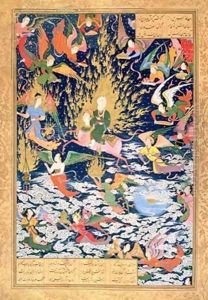Aqa Mirak Paintings
Aqa Mirak was a distinguished Persian painter and calligrapher, born in 1478, during a period when the Timurid dynasty was giving way to the Safavid Empire. His life and work spanned an era of significant transition in Persian art and culture, marking the late Timurid and early Safavid periods. Aqa Mirak is known for his contributions to the development of Persian miniature painting, a form that reached new heights of sophistication and complexity in his hands. His works are characterized by their intricate detail, vivid coloration, and dynamic compositions, reflecting the rich cultural and artistic milieu of his time.
Aqa Mirak worked primarily at the courts of the Safavid Shahs, notably for Shah Tahmasp I, one of the most significant patrons of the arts in Persian history. Under Shah Tahmasp's patronage, Aqa Mirak became a central figure in the development of the so-called Tabriz school of painting, which played a crucial role in the evolution of the Persian miniature. His influence extended beyond painting; as a master calligrapher, Aqa Mirak contributed to the refinement of the Nasta'liq script, which became synonymous with the elegance and fluidity of Persian calligraphy.
Despite the paucity of signed works, art historians attribute a number of important miniatures to Aqa Mirak, based on stylistic analysis and historical records. Among these, illustrations for the Shahnameh (Book of Kings) and the Khamsa of Nizami stand out for their artistic merit and historical importance. These works exemplify his mastery of narrative illustration, his keen eye for detail, and his ability to convey complex emotional and ethical themes through visual means.
Aqa Mirak's legacy is not merely in the beauty of his creations but in his role as a bridge between the Timurid and Safavid artistic traditions. His work reflects the synthesis of Mongol, Chinese, and indigenous Persian elements, which came to define the aesthetic preferences of the Safavid era. Through his contributions, Aqa Mirak helped lay the foundations for later developments in Persian art, influencing generations of artists well beyond his death in 1544. Today, his works are celebrated for their historical significance and artistic excellence, housed in major museums around the world, and continue to inspire admiration and study among art historians and enthusiasts alike.
